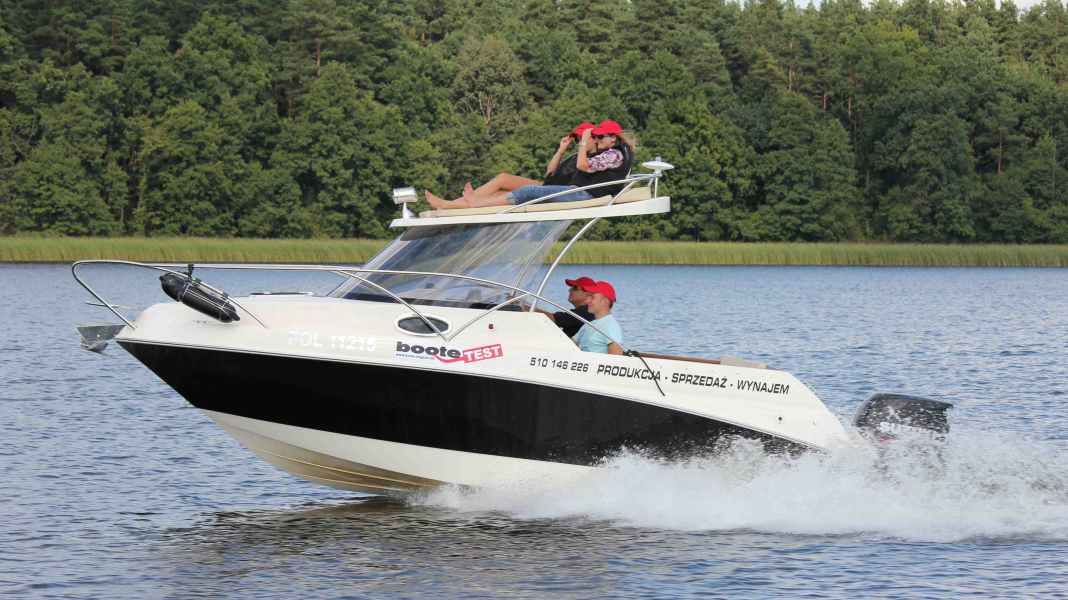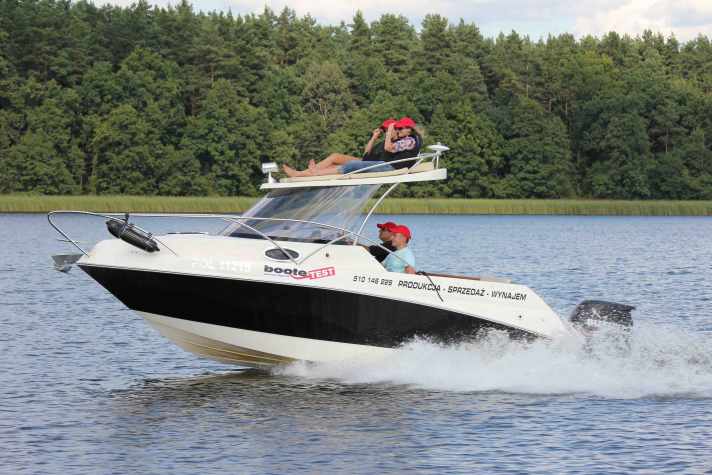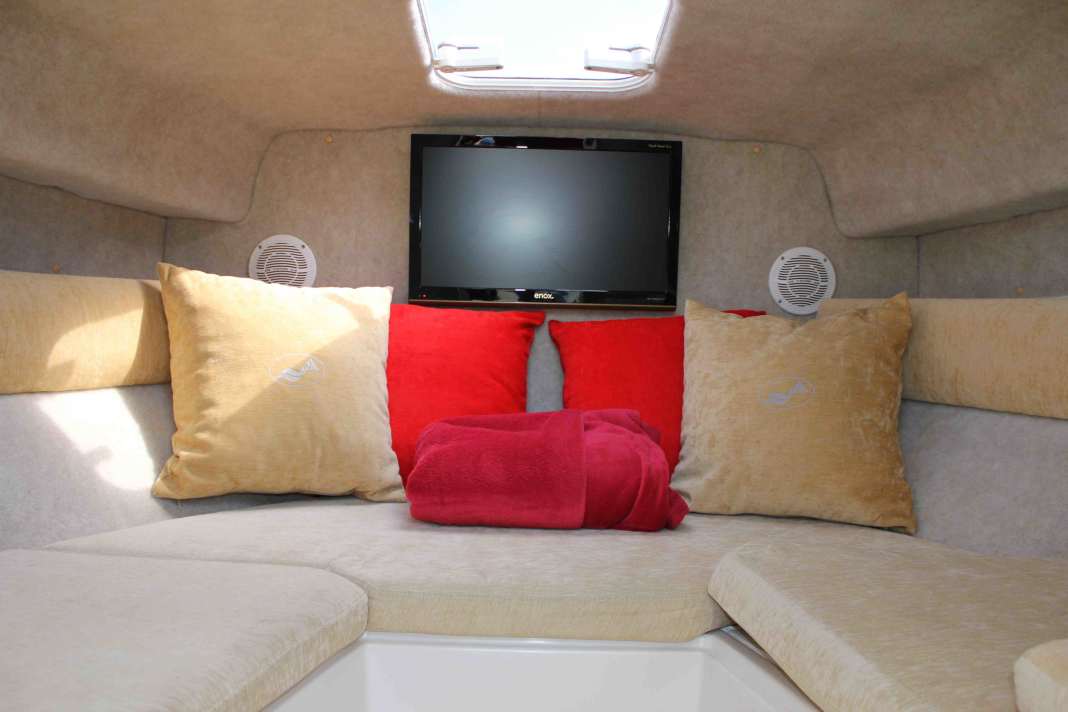

The purpose of hardtops is usually to protect the travelling community from bad weather or excessive sunlight. These are tasks that the roof of our Escapade 600 test boat also fulfils, but the designer Jaroslaw Zywalewski has given it another purpose: sunbathing.

There is a sun cushion for the roof, on which two people can sit comfortably, and a semi-circular railing provides support. According to the designer, this holding option even allows people to stay up there while travelling. A solution that we view critically; life jackets are definitely recommended. However, our test crew said they felt "comfortable and safe".






For other "outdoor living", the shipyard has installed a rear bench with sufficiently firm cushions that can be converted into another sun lounger or emergency berth in a few simple steps. An oval table on a standpipe provides suitable storage space for drinks and snacks. The co-driver and driver's seat can be rotated aft to extend the cosy coffee break. Hot drinks and small hot meals can be prepared on a single-burner gas hob (479 euros), which is conveniently located behind a flap in the starboard side wall, with a knife and chopping board fitting behind the hob. The hand wash/sink is located opposite; the shipyard has provided a cooling facility at the cabin entrance with a pull-out "cooling drawer" (1189 euros).
In the cabin, soft cushions ensure sufficiently cosy seating and reclining comfort. A chemical toilet (integrated into the bench), TV and radio are available for an extra charge. The designer has distributed storage options below and on deck to suit the type of boat.
If you want to take a cool dip, you can do so from the bathing platform on the starboard side. A three-step pull-up bathing ladder, which is hidden under a non-slip cover (bathing platform step), helps here. This hatch is difficult to open from the water. To rinse off the salt water after bathing, there is a stern shower (package with cockpit sink €789) with cold water.
Suzuki's DF 150 hangs from the transom of our test boat, accelerating the boat to a respectable 38.3 knots. At 5900 rpm, the engine turns in the upper range of the permitted full load speed, which is a sign of good propeller tuning. The fact that not only the speed and prop are right, but also the tank capacity of 137 litres, is shown by the range of 108 nm plus 15 % reserve at an economical speed of 23.1 kn (4000 rpm). At full throttle it is about 1/4 less.
The transition range from displacement to planing speed is between 2200 rpm and 3400 rpm. With the outboard fully trimmed to the transom, the rising bow is in view for about two to three seconds before the course-stable planing begins. The co-driver and driver have a reasonable view ahead, while the passengers in the rear seats have no direct view forwards. If you press the power trim button (in the "up" direction) for too long, you will quickly notice that the boat is rocking (in our case just under 1/2 without a passenger on the roof). The water ski wave has an appealing height for amateurs.
The hull makes its rounds in fast port circles without rocking. To starboard, on the other hand, the Esacapade tends to rock at the narrowest point and you voluntarily take the throttle away. However, the simple turn is easy to make. The hull responds to slaloms and steering twists with safe handling characteristics. The steering is sufficiently smooth during fast manoeuvres.
There was no rough water during the test on Lake Necko in Poland - the Escapade skips waves from other boats without any problems.
In the harbour, it impresses with tight turning circles and direct reversing behaviour in reverse. In the latter case, you must not exceed around 2000 rpm to prevent water from pushing into the cockpit via the self-draining system. The shipyard wants to eliminate this problem.
At slow speeds of around 4.5 knots, the boat runs with reasonable course stability. Weight shifts only have a minor effect on the course stability. The heeling, on the other hand, is clearly noticeable, which is also evident at a fast displacement speed of around 6.5 knots. Visibility through the curved Plexiglas windscreen is fine for driver and passenger, even at low speeds. Restriction: There is no windscreen wiper as standard in the rain. Reflections from the white windscreen are moderately distracting and the driver's view of the instruments is unclouded. The driver sits on a softly upholstered sports seat that offers good lateral support. The gearstick and steering wheel are easy to operate both sitting and standing.
The shipyard has safely routed the connecting lines and hoses in protective pipes in the floor; they are neatly bundled under the outboard hull. From the onboard outlet to the outboard motor, they are laid in an exemplary manner in a flexible protective tube. The same care has been taken throughout the boat. The batteries are securely held in plastic boxes with straps. The corresponding selector switch (1, 2 or both) is neatly accessible under the rear bench. The shipyard has installed fuses next to the main switch and on the rocker switches at the helm. Plus points on the tank system: securely mounted stainless steel tank with potential equalisation, labelled and secured tank cap. Minuses: only one screw clamp on some of the fuel lines, no stopcock and extra fuel filter.
The safety equipment includes non-slip floor structures, handholds aft and on the bathing platform, railing, fire extinguisher and electric bilge pump. We did not find the important manual bilge pump on the standard list.
Praise: The convertible top with large foil windows costs no extra. The same applies to the horn and position lights with Euro approval.
Conclusion: The Escapade 600 is a well-built cabin cruiser that is easy to trailer and appeals not only to advanced boaters but also to beginners.

